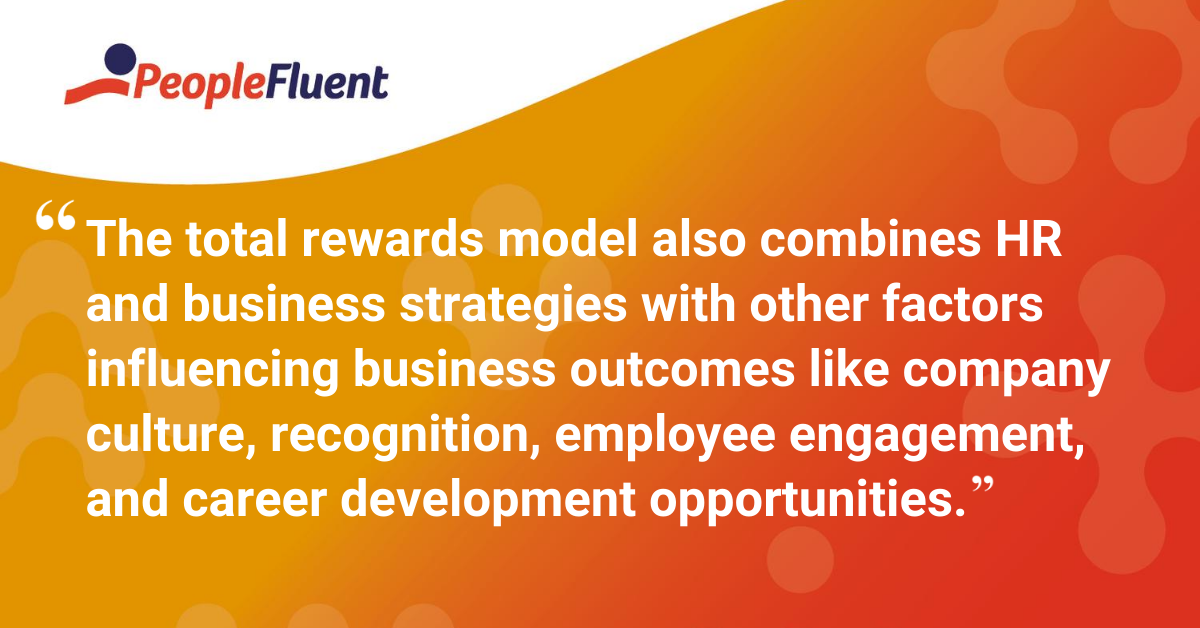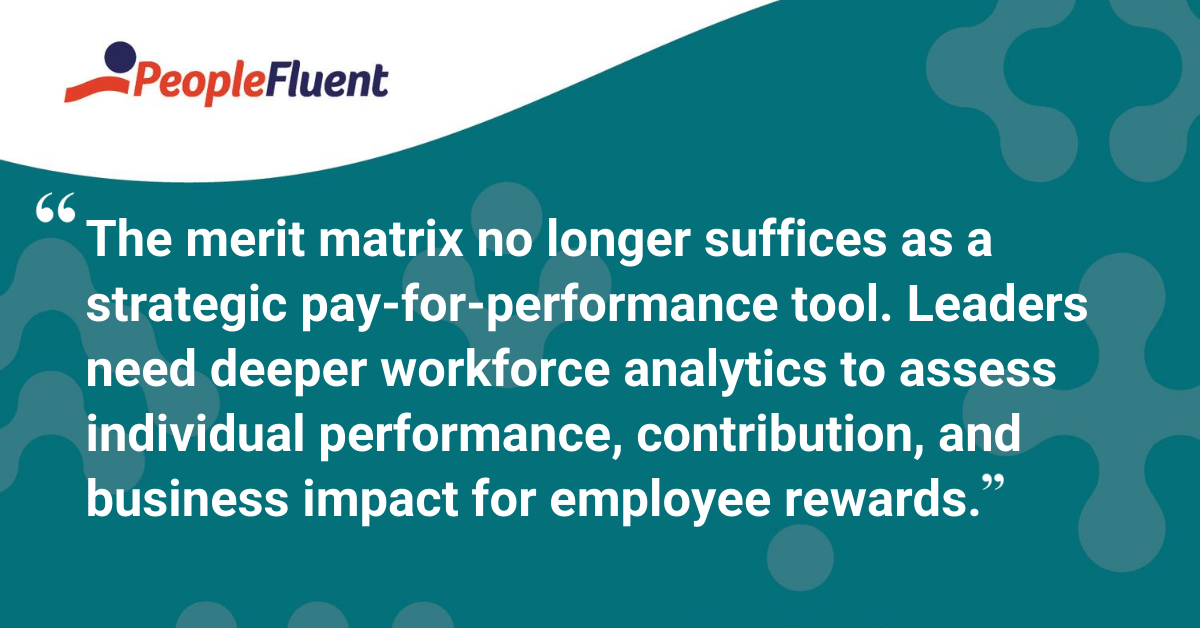Published: Jun 12, 2019Time to read: 6mins Category: Compensation
Total Rewards: 4 Topics on Compensation and Performance
Now that we’ve settled back into our day-to-day routine after WorldatWork’s 2019 Total Rewards Conference, we must begin reflecting on the current landscape of employee compensation and performance management.
Where are our organizations now? How can our HR teams advance at pace with trends in talent management?
If you didn’t get a chance to attend 2019 Total Rewards, below you’ll find an overview of a few of the most talked-about issues facing talent management leaders today in employee compensation and performance management, plus insights that aim help leaders move toward a total rewards model.
You might also like: 'The Top 4 Benefits of Using Compensation Management Software'
What is a Total Rewards Model?
The total rewards strategy is a unified approach to providing compensation, benefits, and development opportunities to employees who achieve performance and company objectives.
Performance is not the only element though—the total rewards model also combines HR and business strategies with other factors influencing business outcomes like company culture, recognition, employee engagement, and career development opportunities.
4 Topics in Total Rewards: Compensation and Performance Management
1. Compensation Strategies and Pay Equity
Equal pay continues to be a topic of conversation—and for good reason. It still exists.

The current state of organizational priorities is staggering:
- Only 9.9% of organizations say closing the pay gap is one of their highest priorities.
- 45.8% of organizations report that gender pay equity is important.
- Just over half of leaders state they perform a formal assessment of gender pay equity.
Obviously, it’s imperative that organizations work to close the wage gap to prevent legal ramifications. But maintaining a commitment to pay equity for our employees’ total well-being should drive efforts to improve our compensation strategies.
Discover more: '4 Best Practices for Achieving Greater Pay Transparency'
2. Personalized Total Employee Rewards
Employees want rewards that reflect how they work, learn, communicate, and live. That means the traditional one-size-fits-all approach to performance assessment, compensation planning, and employee recognition just won’t cut it anymore.
Workforce data indicates that companies aren’t keeping up with employee expectations and that
- Only 8% of employees say that their rewards program is very effective at providing agile, personalized total rewards.
- 20% of organizations conduct performance appraisals, yet under 10% adjust salary at that rate.
- Organizational growth increased by at least 10% at companies that aligned employee rewards with business goals.
In light of data like this, we should ask ourselves:
- Are our business goals and talent management strategy clearly aligned?
- Do we measure performance regularly? Adjust our compensation strategy at pace? And reward our employees properly?
3. Pay-for-Performance Structures and the Merit Matrix
While debates on performance management aren’t anything new, it’s clear that a performance management revolution is underway. Traditionally, salary administration processes are tied to the concept of the merit matrix—a basic pay-for-performance tool that determines salary increases based on two variables: performance rating and range penetration (or compa-ratio).

While the merit matrix leans toward a pay-for-performance strategy, these variables alone are too limited to ensure an effective distribution model. And without more workforce data (e.g., loss impact, potential, and promotability) against which to audit manager recommendations, organizations can easily misallocate and overspend millions of dollars during the salary administration process.
In a time of narrowing margins and cost controls, compensation strategies must adapt to evolving market trends, business strategies, and employee needs.
Effectively driving employee performance requires rewards strategies that
- Optimize distribution to the right talent
- Account for future potential, growth, and advancement
- Provide incentive for experiential learning and development to close skills gaps
- Retain key resources that materially impact the organization.
Structured and comprehensive rewards strategies produce more equitable pay processes and decrease the potential for managers’ discretionary recommendations to influence governance over operational workforce data.
4. Effective Leadership Communication
Remember earlier when we talked about personalized employee rewards? We’re coming full circle now.
Research by Bersin found that high-performing organizations are 6x more likely to use data and analyses to understand employee preferences for rewards. While employee feedback about their needs and values is helpful in developing a total rewards strategy, leaders have to recognize that an effective culture of communication means information must flow both ways.
Our employees want transparency about compensation decisions and performance management strategies—to know the components that impact their own work, including
- Expectations for their performance
- How those standards tie to their unique skills
- How their role and contribution fit into the larger organization.
When managers clearly understand the broader scope of their total rewards strategy, they can better articulate the context and justification to their employees at a comprehensible level.
More on compensation: '4 Secrets to Pay Transparency Success'
So what does this all mean? I’ve wrapped up my most notable takeaways from the conference to help compensation leaders move forward into the total rewards revolution.
7 Key Takeaways from the 2019 Total Rewards Conference

1. Executives, compensation managers, and other HR leaders must work together to create a pay strategy aligned with business objectives and employee values.
2. Compensation planning should include benchmarking total employee compensation with the market standard and a pay level comparison using relevant metrics (e.g., employee background, work similarities, and qualifications).
3. The merit matrix no longer suffices as a strategic pay-for-performance tool. Leaders need deeper workforce analytics to assess individual performance, contribution, and business impact for employee rewards.
4. Monetary rewards aren’t the only motivation for improving employee performance. Employees want meaningful work, career mobility, and flexible rewards that reflect their contribution.
5. Performance management strategies must be capable of adapting to tech disruption, advances in automation, human capital trends, and changes in the demand for workforce skills.
6. A total rewards model must fit into an organization’s holistic talent strategy by strengthening the connection between talent acquisition, talent management, and employee learning and development.
What’s Next for Performance and Compensation Management?
There’s no denying that the US labor market is tighter than ever. And the skills gap is very real.
HR leaders are going toe-to-toe with challenges associated with these types of human capital trends, on which total rewards have a direct impact.
We can’t say exactly what the future of work holds. What we can do, however, is restructure our compensation and performance management programs into a holistic talent framework that supports flexibility, governance and accountability, award optimization, communication, and—of course—our employees.
Discover How to Reward People and Stay Competitive
PeopleFluent software provides the tools to help you plan and execute complex compensation plans, so you keep within your budget while attracting, rewarding, and retaining top performers.